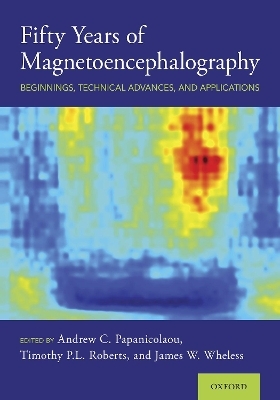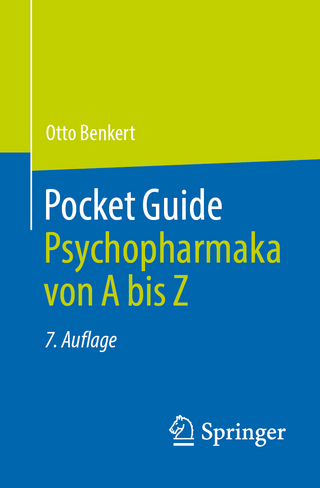
Fifty Years of Magnetoencephalography
Oxford University Press Inc (Verlag)
978-0-19-093568-9 (ISBN)
Andrew C. Papanicolaou is Professor of Clinical Neuroscience Emeritus of the University of Tennessee, College of Medicine, where he served as founder and Chief of the Division of Clinical Neuroscience; visiting Professor of Neurology at the National University of Athens, Greece; President of the advisory board of the Center of Applied Neuroscience of the University of Cyprus and honorary member of the Hellenic Clinical Neurophysiology and Neuropsychology Societies. Timothy P.L. Roberts is a Professor of Radiology at the Children's Hospital of Philadelphia, University of Pennsylvania. He received his BA from Cambridge University in 1988 and his PhD, also from Cambridge University, in 1992. He has developed a career in multimodal neuroimaging, especially using MEG, MRI, and MRS and been on the faculty at UCSF and the University of Toronto before his arrival at CHOP/University of Pennsylvania in 2005. James W. Wheless is a Diplomate of the American Board of Pediatrics, and the American Board of Psychiatry and Neurology with special qualifications in Child Neurology, Clinical Neurophysiology, and Epilepsy. He is a fellow of the American Academy of Pediatrics, the American College of Pediatrics, the American Academy of Neurology, and the American Epilepsy Society. Dr. Wheless is a member of the Editorial Board for the Journal of Child Neurology, Formulary, and Epilepsy.com and serves as reviewer of a number of journals including: Neurology, Epilepsia, Pediatrics, and Epilepsy and Behavior.
PREFACE
Section One: The Beginnings
1. THE FIRST MEG REPORT: 1968
David Cohen
Massachusetts Institute of Technology
2. THE BEGINNING OF BIOMAGNETISM AND MEG RESEARCH IN FINLAND IN THE 1970s
Toivo Katila
Helsinki University of Technology
3. A VIEW FROM NEAR THE BEGINNING OF MEG: AFTER HALF A CENTURY
Lloyd Kaufman
New York University
Section Two: Technical Advances
4. PHYSIOLOGICAL BASES OF MEG AND EEG
Yoshio Okada
Boston Children's Hospital and Harvard Medical School
5. WHICH PART OF THE NEURONAL CURRENT CAN BE DETERMINED BY EEG?
A.S. Fokas, P Hashemzadeh and R. Leahy
University of Cambridge and University of Southern California
6. MEG SOURCE ESTIMATION: TRANSFORMING THE SENSOR-LEVEL SIGNALS TO ESTIMATES OF BRAIN ACTIVITY
Matti S. Hämäläinen
Massachusetts General Hospital and Harvard Medical School
7. The Need for and the Road to Hybrid MEG-MRI
Risto J. Ilmoniemi
Aalto University School of Science
8. MAGNETOENCEPHALOGRAPHY USING OPTICALLY PUMPED MAGNETOMETERS
Elena Boto, Niall Holmes, Tim Tierney, James Leggett, Ryan Hill, Stephanie Mellor, Gillian Roberts, Gareth Barnes, Richard Bowtell and Matt Brookes
University of Nottingham and the Wellcome Trust Centre for Neuroimaging, University College London
Section Three: Applications to Epilepsy
9. GUIDELINES AND PRACTICAL CONSIDERATIONS FOR MAPPING EPILEPTIFORM ACTIVITY WITH MAGNETOENCEPHALOGRAPHY
Roozbeh Rezaie, James W. Wheless, and Abbas Babajani-Feremi.
The University of Tennessee Health Science Center
10. BEYOND THE IRRITATIVE ZONE: USE OF MEG TO CHARACTERIZE ASPECTS OF THE EPILEPTOGENIC ZONE
Eduardo M. Castillo, Tara Kleineschay, Milena Korostenskaja , James Baumgartner and Ki Hyeong Lee
Florida Hospital for Children
11. USE OF MULTIPLE FREQUENCY BANDS IN MEG FOR CHARACTERIZATION OF EPILEPSY
Woorim Jeong and Chun Kee Chung
Seoul National University
12. CAN MAGNETOENCEPHALOGRAPHY IDENTIFY THE EPILEPTOGENIC PATHOLOGY IN CHILDREN?
Won Seok Chang and Hiroshi Otsubo
The Hospital for Sick Children, University of Toronto
13. REVISIONAL ANALYSIS OF EEG AND MEG BASED ON COMPREHENSIVE EPILEPSY CONFERENCE
Nobukazu Nakasato, Akitake Kanno, Makoto Ishida, Shin-ichiro Osawa,
Masaki Iwasaki, Yosuke Kakisaka and Kazutaka Jin
Tohoku University Graduate School of Medicine
14. EPILEPTIC SLOW WAVE ACTIVITY
Stefan Rampp and Martin Kaltenhäuser
University Hospital, Erlangen University
Section Four: Somatosensory, Motor and Language Mapping
15. CLINICAL MOTOR MAPPING WITH MEG: HISTORICAL APPROACHES, CHALLENGES AND RECOMMENDATIONS FOR BEST PRACTICE
William Gaetz, PhD.
The Children's Hospital of Philadelphia, University of Pennsylvania
Christos Papadelis, Boston Children's Hospital, Harvard Medical School and
Tony Wilson, University of Nebraska Medical Center
16. INVESTIGATIONS OF THE SOMATOSENSORY SYSTEM WITH MEG: FROM RESEARCH TO CLINICAL APPLICATIONS
Xavier De Tiègeand
Hôpital Erasme, Université libre de Bruxelles and
Veikko Jousmäki, Aalto University School of Science and Nanyang Technological University
17. LANGUAGE MAPPING WITH MEG: CLINICAL AND RESEARCH APPLICATIONS
Panagiotis G. Simos
University of Crete, School of Medicine
Susan M. Bowyer
Henry Ford Hospital and Wayne State University
Kyousuke Kamada
Asahikawa Medical University
Section Five: Exploring the Brain Mechanisms of Cognition
18. READING, READING ACQUISITION AND READING DISABILITY (DYSLEXIA) Panagiotis G. Simos
University of Crete School of Medicine
19. MEG DECODING COGNITIVE FUNCTION WITH MEG
Dimitrios Pantazis
Massachusetts Institute of Technology
20. HOW BRAIN RHYTHMS REFLECT COGNITIVE PROCESSES
Joachim Gross
Westphalian-Wilhelms-University of Muenster
Section Six: Neuronal Correlates of Cognitive and Affective Disorders
21. APPLICATIONS OF MEG TO AUTISM SPECTRUM DISORDER
Kristina Safar, Margot J. Taylor,
Hospital for Sick Children, Toronto
Junko Matsuzaki and Timothy P.L. Roberts
Children's Hospital of Philadelphia
22. FUNCTIONAL WOUNDS OF AN INVISIBLE INJURY: VISUALIZING COGNITION IN PTSD
Benjamin T. Dunkley and Margot J. Taylor
Hospital for Sick Children, University of Toronto
23. IDENTIFYING NEURAL ABNORMALITIES IN SCHIZOPHRENIA
J. Christopher Edgar
Children's Hospital of Philadelphia and
Gregory A. Miller
University of California, Los Angeles
24. BIOMARKERS IN PEDIATRIC MEG
Julia M. Stephen, Isabel Solis, John F.L. Pinner, Felicha T. Candelaria-Cook
The Mind Research Network, Lovelace Biomedical and Environmental Research Institute
and The University of New Mexico
25. MAGNETOENCEPHALOGRAPHY IN Alzheimer's disease: CORRELATION WITH CURRENT BIOMARKERS
David López-Sanz; Jaisalmer de Frutos-Lucas; Gianluca Susi, and Fernando Maestú,
Complutense University of Madrid
POSTSCRIPT
| Erscheinungsdatum | 05.08.2020 |
|---|---|
| Verlagsort | New York |
| Sprache | englisch |
| Maße | 257 x 180 mm |
| Gewicht | 1111 g |
| Themenwelt | Geisteswissenschaften ► Psychologie ► Klinische Psychologie |
| Medizin / Pharmazie ► Medizinische Fachgebiete ► Neurologie | |
| Naturwissenschaften ► Biologie ► Humanbiologie | |
| Naturwissenschaften ► Biologie ► Zoologie | |
| ISBN-10 | 0-19-093568-5 / 0190935685 |
| ISBN-13 | 978-0-19-093568-9 / 9780190935689 |
| Zustand | Neuware |
| Informationen gemäß Produktsicherheitsverordnung (GPSR) | |
| Haben Sie eine Frage zum Produkt? |
aus dem Bereich


